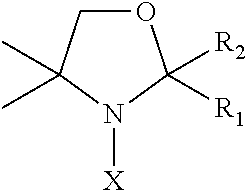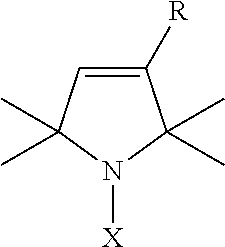Altering expression level of glutathione s-transferase genes by treating a human subject with a nitroxide
a technology of glutathione s-transferase and nitroxide, which is applied in the direction of heterocyclic compound active ingredients, organic active ingredients, medical preparations, etc., can solve the problems of radiation-induced toxicity, chemotherapy-induced toxicity, and dysregulation of downstream actions, so as to inhibit the development of said cancer, increase the activity of gsh, and reduce the expression level
- Summary
- Abstract
- Description
- Claims
- Application Information
AI Technical Summary
Benefits of technology
Problems solved by technology
Method used
Image
Examples
example 1
f Tempol on expression of genes associated with glutathione S-transferase
[0155]To assess the effects of Tempol on gene expression, Tempol was administered to experimental mice at a dose of 5 mg / g of food from 14 months to 31 months after birth. Mice receiving the same food without the addition of Tempol were used as a negative control. At the age of 31 months, the experimental animals were sacrificed and the hearts were surgically removed. The expression of a broad spectrum of genes in white adipose tissue tissue was assessed using chip-based microarray technology. Such chips are well known in the art and are widely used to assess gene expression. The experimental results showed that ten genes associated with glutathione S-transferase, Gstm3, Gstm6, Gsta3, Gstt1, Gsta4, Gstm1, Gstm4, Gstt2, Gstp1, and Gstk1, exhibited statistically significant increase in expression. This result is shown in Table 1.
TABLE 1Genes associated with Glutathione S-Transferase exhibited increasedexpression ...
example 2
Age-Related Decrease in Gene Expression
[0156]A 70-kilogram human subject over the age of 65 is identified for decreased expression level of Gstm3, Gstm6, Gsta3, Gstt1, Gsta4, Gstm1, Gstm4, Gstt2, Gstp1, or Gstk1. The human subject is administered a dose of 1500 mg of a nitroxide antioxidant (e.g., Tempol) per day for 180 days. This may be administered in a single dose, or may be administered as a number of smaller doses over a 24-hour period: for example, three 500-mg doses at eight-hour intervals. Following treatment, the serum level of Gstm3, Gstm6, Gsta3, Gstt1, Gsta4, Gstm1, Gstm4, Gstt2, Gstp1, or Gstk1, is increased.
example 3
a Human Subject with Age-Related Disease
[0157]A 70-kilogram human subject over the age of 65 and having a cardiovascular disease is identified for decreased expression level of Gstm3, Gstm6, Gsta3, Gstt1, Gsta4, Gstm1, Gstm4, Gstt2, Gstp1, or Gstk1. The human subject is administered a dose of 1500 mg of a nitroxide antioxidant (e.g., Tempol) per day for 180 days. This may be administered in a single dose, or may be administered as a number of smaller doses over a 24-hour period: for example, three 500-mg doses at eight-hour intervals. Following treatment, the serum level of Gstm3, Gstm6, Gsta3, Gstt1, Gsta4, Gstm1, Gstm4, Gstt2, Gstp1, or Gstk1, is increased.
PUM
| Property | Measurement | Unit |
|---|---|---|
| pKa | aaaaa | aaaaa |
| concentration | aaaaa | aaaaa |
| particle size | aaaaa | aaaaa |
Abstract
Description
Claims
Application Information
 Login to View More
Login to View More - Generate Ideas
- Intellectual Property
- Life Sciences
- Materials
- Tech Scout
- Unparalleled Data Quality
- Higher Quality Content
- 60% Fewer Hallucinations
Browse by: Latest US Patents, China's latest patents, Technical Efficacy Thesaurus, Application Domain, Technology Topic, Popular Technical Reports.
© 2025 PatSnap. All rights reserved.Legal|Privacy policy|Modern Slavery Act Transparency Statement|Sitemap|About US| Contact US: help@patsnap.com



